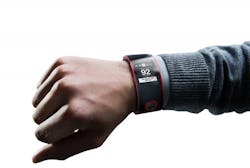Here’s an intersection between technology and motor vehicle operation many might have overlooked: how the new trend towards “wearable” technology like Google’s glass and other offerings might help – and yet also hinder – drivers of both cars and trucks.
Global consulting firm ABI Research posits that the next “logical” step following in the wake of in-vehicle smartphone integration is the interface of “wearable form-factors” – directly or via phones – with more than 90% of vehicles around the world by 2019.“While head unit proximity touch screens, heads up displays and speech recognition are now well established, the quest for next-generation automotive HMI [human machine interface] is still on with gesture recognition, eye control and augmented reality edging closer to implementation,” explained Dominique Bonte (at right), ABI’s VP and automotive practice director.
“At the same time, wearable form-factors are being explored bearing testimony to the automotive industry’s objective to keep up with consumer electronics innovation,” he added. “But they also contribute to creating a seamless digital user experience inside and outside the vehicle.”
Bonte noted that in-vehicle wearable integration is the latest trend in automotive design, referencing a few recent developments such as Hyundai’s Blue Link Glassware application, Mercedes’ Pebble smart watch Digital DriveStyle application, BMW’s i3 EV Samsung Galaxy Gear smart watch integration, INRIX’s real-time traffic Google Glass demo app, and Nissan’s Nismo concept smart watch displaying biometric and vehicle diagnostics and performance data (more on that one later).
However, he also said that use of wearables in cars is controversial (no duh!) with many governments dismissing them for safety reasons.
“Legislation banning eyewear is already being prepared in several U.S. states and in the U.K.,” Bonte pointed out. “But jurisdiction seems to be lacking as illustrated by cases dismissed on grounds it could not be proven the device was either switched on or a distracting application used. Clearly, it is not the form-factor which should be banned but certain use cases such as watching videos.”
He also noted there are positive safety benefits to “in-vehicle wearables” to consider as well.“Eyewear functioning as dash cams or for displaying blind spot or collision safety alerts will contribute to safer driving, not deter it,” Bonte stressed. “At the same time wearables will kick start a thriving aftermarket connected car application ecosystem."
Now, Nissan’s new “smart watch” concept certainly can’t display all the visual information the way Google’s glass eyeshades can, but it does provide an example of the new ways technology is being envisioned as a connector between vehicles and driver performance.
Nissan’s “Nismo Watch” is also supposedly geared towards athletes, so they can monitor their own personal performance as well as that of their car. It’s a device designed to:
- Monitor the efficiency of their vehicle with average speed and fuel consumption readings
- Access vehicle telematics and performance data
- Capture biometric data via a heart rate monitor
- Connect to the car using a smartphone app via Bluetooth Low Energy
- Receive tailored car messages from Nissan
Dunsmore said three key technologies have already identified for future development for the Nismo Watch:
- ECG (Electrocardiogram) to measure rhythm of heartbeats and identify early fatigue
- EEG (Electroencephalogram) Brainwave to monitor the drivers' levels of concentration and emotions, and help athletes to get 'In the Zone'
- Skin Temperature for recording core body temperature and hydration levels
Now, think about some of those features in relation to the trucking world: it could really be ideal in terms of providing a simple way for truck drivers to keep tabs on their ability to monitor personal fatigue and how it affects their concentration. And, if worn in the form of a watch, that technology might not be very distractive at all in terms of interfering with truck operations.
It’s still early days where the development and eventual use of wearable technology in the world of motor vehicles is concerned of course. But it’s never too early to start studying what the impact of such technology might be upon a driver’s ability to operate a vehicle efficiently and safely.



